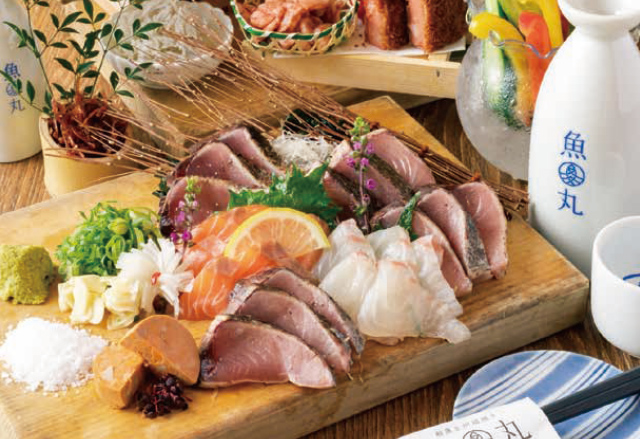Uomaru
Uomaru
A fish-forward izakaya in central Hikone
place Area: Hikone
access_time Published: 2020.10.07
Name in Japanese: 魚丸
Pronunciation: oo-o maru
When you walk out of Hikone station, you’re faced with a bewildering choice of eateries lining the road to the castle. One of these is Uomaru, an izakaya-style restaurant whose first character ‘uo’ means ‘fish’, reflecting the particular focus of the establishment. I went for dinner on a warm summer night when the French windows facing the street were open and locals were dropping in.
Urabe Toshiharu the manager showed me to a counter seat overlooking the busy kitchen. Uomaru has a range of seating, with open tables, booths, and private rooms upstairs. With its wooden furniture and tightly aproned staff, the restaurant somehow resembles a Wild West saloon, in spite of the shamisen background music.
Since Shiga is landlocked, I’m curious about where the fish comes from.
“A lot of our fish is landed from the Japan Sea at Kyōto and Fukui. But one of our specialties is authentic katsuo no tataki. For that we have bonito tuna delivered from Kōchi. Katsuo no tataki is made by searing outside of the fish over flaming rice straw. Because the straw burns at high heat, the edges of the fish become crispy, and the aroma of the straw adds a savoury note to the tuna.”
“Do you use any fish from the Ōmi region?”
“Yes, we serve wild Biwa trout. The season for trout is nearly over now.”
Urabe-san brings a wooden tray laden with various sashimi on a bed of ice with garnishes of sliced vegetables and edible leaves. It’s a wonderfully colourful sight.
The young serving lady brings a bottle of dry Kirakuchō sake.
“Although it’s dry, it has a fruity character that complements sashimi nicely.”
Throughout the meal, she provides these handy little commentaries on the sake. It’s a joy to have well-informed service.
The sashimi platter includes fish with varying degrees of oiliness – the salmon is very rich indeed, while the Biwa trout is light and delicate. Both match the recommended sake perfectly.
On the other side of the counter, the chef is readying some katsuo no tataki. In quality restaurants, this is always prepared directly before serving. The fillets of tuna are arranged on a rack and the straw is lit. Tall flames rise up and the flames are fed in turn by the sizzling oil that drips from the fish. A wonderful aroma wafts my way. Meanwhile, the server has more sake recommendations, and this time there’s a choice – Kure, from Kōchi where the tuna comes from, and a Daijirō kimoto. “Kure is brewed specifically to go with seared tuna, but Daijirō from Ōmi happens to have a similar profile. It’s a difficult choice. Maybe a cup of each?”, suggests Urabe-san. Strange to say, but the local Daijirō seems to go best with the succulent, smoky tataki topped with a little sliced garlic. It’s a sublime match.
Where possible, Uomaru uses locally sourced ingredients. The next dish, lightly fried burdock sticks with mayonnaise, is produced nearby. Before frying, the burdock is tenderised by simmering in a light stock. This too is a perfect companion to sake. I catch the eye of the young cook in the kitchen who prepared the burdock, and smile him my complete satisfaction. He beams back.
“The menu seems to feature a lot of fish. Do you offer anything else?”
“Yes. Although our main focus is high-quality fish, we have enough alternatives to satisfy anyone, including Ōmi beef dishes.”
In addition to the wonderful izakaya food, you can enjoy the little design elements that make the Uomaru brand, from the fish in a circle logo to the amusing graphics on the glasses that celebrate Japan’s izakaya culture.
Location
place 7-21 Asahimachi, Hikone, Shiga prefecture

